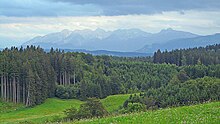Kempter Forest


The Kempter Wald (also Kempten forest ) is a large-scale forest area east of Kempten (Allgäu) in the field of counties upper and Ostallgäu . The forest is partly located in the homonymous community-free area. The Kempter Forest reaches heights of up to approx. 960 m above sea level. NHN south of Hauptmannsgreut and near Bodelsberg.
geography
The Kempter Forest is part of the pre-alpine Allgäu moor and hilly landscape, which was shaped in the last Ice Age . One of the largest collections of erratic boulders in the entire northern Alps dates from this time, with over 4000 erratic boulders , with the largest ( Dengelstein , Beichelstein, Baltenstein, der Stein) reaching considerable sizes of over 3000 m³ and 20 m in diameter.
The forest is the headwaters of several streams and small rivers (e.g. the Kirnach ), the water of which flows into the Iller or the Wertach . 54.4% of the area of the Kempter Forest are subject to European or national nature conservation legislation. The FFH area "Kempter Wald mit Oberem Rottachtal " is identical to this proportion, the special protection areas (bird protection areas according to an EU directive) include 6.8% of the area and the nature reserve proportion is 7.2% (as of 2003) .
history
The prince abbots of Kempten built 80 fish ponds in the Kempter Forest and counted it among the “areas with the most hunting in Germany”. The rights of use in the Kempter Forest (logging, hunting, forest pasture, customs) were repeatedly the subject of disputes between the prince monastery and the imperial city of Kempten. As early as 1373, the then prince abbot had an existing mule track through the forest expanded into a passable road. The prince abbot also had a customs post in the forest on an old Roman road that used to lead from Kempten to Reutte and connect there to the Via Claudia (the Zollhaus-Petersthal railway station of the Ausserfernbahn is nearby ). In 1694 he wanted to build a road from his customs post to Immenstadt in competition with a road planned at the same time from Feldkirch over the Arlberg in order to lead trade past the imperial cities of Kempten, Isny, Wangen and Lindau directly to Bregenz. However, the project failed due to the objection of the imperial cities including Augsburg, the Duchy of Württemberg and the Bishop of Constance.
The Swabian-Allgäu hiking trail leading from Augsburg to Lake Constance (also part of the Munich Way of St. James ) crosses the Kempter Forest. It leads past the forest chapel built in 1938 in the middle of the forest.
Attractions
The medieval castle Wolkenberg stood in the Kempter Forest in what is now the municipality of Wildpoldsried and has been preserved as a ruin. The Neuchâtel ruins are located near the municipality of Durach . A refuge is also mentioned. Traditional excursion destinations include various inns in the Kempter Wald (Tobias, serving since 1894; Waldschenke, since 1912; Adler in Bodelsberg, serving since 1526; Hauptmannsgreut), the managed rural Alps Alpe Beilstein and Mehlblockalpe and the Stellbrunnen barbecue area.
literature
- Alpstein Tourismus (publisher): Kempter Wald hiking map (1: 25,000), Immenstadt 2008 (available in neighboring communities)
- Rüdiger Filger: Litter and wet meadows in the Kempter Forest , dissertation: Kassel, University, Department of Organic Agricultural Sciences, 2007 ( online resource )
- M. Müller, H. Scholz: News about the erratic boulder field of the Kempter Forest in the Allgäu. Reports of the Natural Science Association for Swabia., Vol. 115, Augsburg 2011, pp. 95–127.
Web links
Individual evidence
- ↑ M. Müller, H. Scholz: News about the erratic boulder field of the Kempter Forest in the Allgäu. Reports of the Natural Science Association for Swabia., Vol. 115, Augsburg 2011, pp. 95–127

